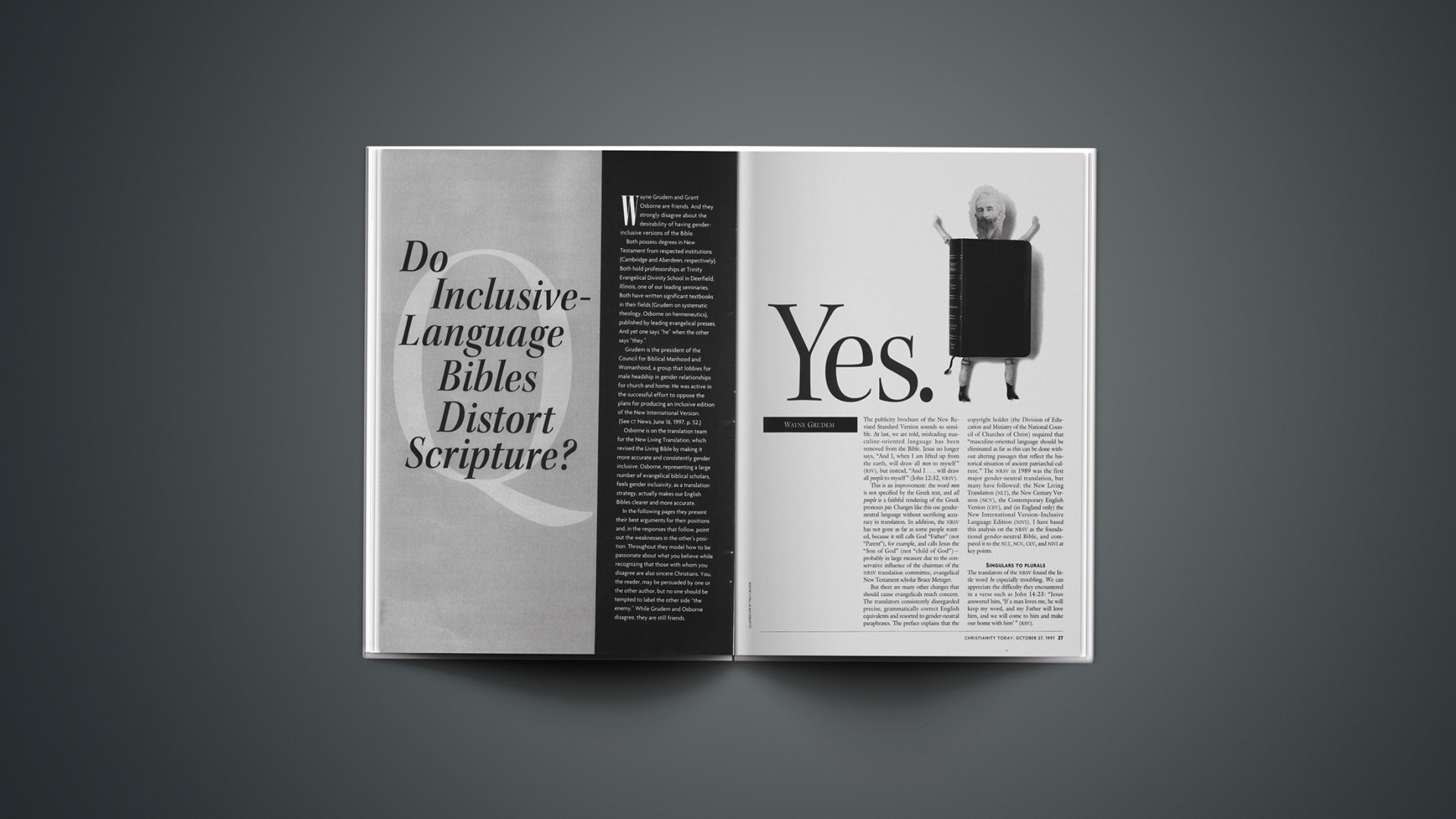Part three of four parts; click here to read part two.
Grant R. Osborne: NO Whether or not to use inclusive language in Bible translation is not a gender issue but a matter of translation theory. Those of us who believe in the use of inclusive language are not trying to force a feminist agenda on evangelicalism. Many who use inclusive language, in fact, are affiliated with the Council on Biblical Manhood and Womanhood (CBMW). We must be careful about attributing motives to actions.
The true question is whether formal equivalence or functional equivalence, as Bible translation theories, produces the best translation for our day. Formal equivalence (sometimes called “literal translation”) believes that the original wording, grammar, and syntax should be retained so long as the resulting translation is understandable (KJV, NASB, and RSV are examples). Functional equivalence (also called “dynamic translation”) believes that the text should have the same impact on the modern reader that the original had on the ancient reader. According to this approach, it is not the original terms but the meaning of the whole that is important, asking the question, “How would Isaiah or Paul say this today to get his meaning across?” (the Good News Bible and NLT are examples; NIV and NRSV are sometimes literal, sometimes dynamic). The first is a “word-for-word” translation and the second a “thought- for-thought” translation.
For instance, Matthew 5:3 in the New American Standard Bible reads, “Blessed are the poor in spirit, for theirs is the kingdom of heaven,” but the New Living Translation reads, “God blesses those who realize their need for him, for the kingdom of heaven is given to them.” Functional equivalence tries to communicate the meaning of blessed and poor in spirit rather than simply to translate the words themselves. It does not ignore the words but rather translates the ideas behind the words.
In fact, a purely literal translation is impossible. The King James Version and the NASB do not keep every nuance of the original intact, nor can they. Every translator has to decide the best way to translate the words of one language into another, and that means changing not only words but also idioms and grammatical structures. Translation by slide rule cannot be done, and decisions have to be made.
MAKING SCRIPTURE CLEAR The use of inclusive pronouns in translations falls within the realm of dynamic translation theory. In the ancient world it was common to say “man” or “he” when speaking of all people. The influence of the KJV has made it common until recent years to do the same. Within the last two decades, however, this is practiced less and less, and those who have not grown up in the church can misunderstand such male-oriented language. (You do hear it now and then in newscasts, but normally by older commentators who grew up with the idiom.) Even if the inclusive he is retained in some stylebooks, it is impossible to deny that its occurrence is becoming rarer or that ultimately it is on its way out in modern language. A basic principle of all translation theory is to express the ancient text in the thoughts and idioms of the receptor language.
While it is true that the “feminist” agenda launched the protest against the inclusive he, the issue has gone beyond ideological boundaries. The public as a whole, whether sympathetic or not to the feminist cause, is reluctant to use he or man when referring to all people. In the public schools, he has not been used for years to speak of both men and women, and most young people under 30 have not grown up with its use. As Jerold Apps says in Improving Your Writing Skills, “People are often confused when words like he and man are used to mean sometimes men and sometimes both sexes.” Therefore, biblical scholars more and more are translating male pronouns, when they refer to men and women, with a plural.
Both formal and functional techniques have the same goals—accuracy, clarity, and rhetorical power. Literal translations prize word-for-word accuracy, and dynamic translations seek both accuracy and clarity in communicating the meaning of the text. However, it is a very real question whether the retention of an inclusive he is really more accurate.
If the biblical author is referring to both men and women, it is more accurate to state such in the translated text. If man and he refer to all people in the original text, then the principle of accuracy favors rendering them as person or they in the translation.
There is room for both literal and dynamic translations. For those who do not know the biblical languages, literal translations are a necessity for serious Bible study. For those who want to understand the message of the text clearly, a dynamic translation is indispensable. There is room for both the retention and the replacement of male pronouns and terms in various versions. Neither is wrong; both have distinctive purposes. One lets the reader know exactly how the ancient author worded his message; the other tells the reader exactly what he meant.
Let us remember Paul’s principle in 1 Corinthians 9:22—”I have become all things to all people so that by all possible means I might save some” (NIVI). This has become an important missiological mandate. It means that, in any receptor culture that does not oppose the gospel, the missionary/Christian must adapt to make the gospel proclamation accessible to the people. The task is to be culturally relevant without being culture bound. Whenever a detail within a culture is not inimical to biblical Christianity, the church should adapt its proclamation to that practice. Replacing man with people or he with they does not contradict the meaning of the biblical text, while retaining them can be, at worst, offensive and, at best, misleading to many modern people.
Those of us who believe in the use of inclusive language are not trying to force a feminist agenda on evangelicalism.
The American Heritage Book of English Usage states, “It is undeniable that large numbers of men and women are uncomfortable using constructions that have been criticized for being sexist. Since there is little to be gained by offending people in your audience, it makes sense … to try to accommodate at least some of these concerns.” It is likely that Paul today would not use such unnecessarily offensive language as man or he when it refers to men and women. (For instance, see Psalm 32:1, “Blessed is he whose transgression is forgiven,” which Paul quotes in Romans 4:7 as “Blessed are they whose transgressions are forgiven,” NIV.) This is not capitulating to a feminist agenda but exercising evangelistic sensitivity toward those (including many evangelicals!) who can be offended by such.
POINTS OF AGREEMENT Let us now turn to specific issues. In many areas I agree with those who oppose certain changes mandated by radical feminists. For instance, I would not change the names of God. God should be “Father” and Christ “Son of Man” and “Son of God.” Moreover, when the context indicates men are clearly being addressed, we should retain male language. For instance, in the parable of the tenant farmers in Luke 20:9-18, the farmers are clearly men, so we retain the male pronouns (NLT: “A man planted a vineyard … he sent one of his servants,” 20:9, 10).
The difficulty comes when men are being addressed in the ancient setting, but men and women would be addressed in the modern setting. In many of those instances, communication is better served by changing the pronouns lest the modern reader mistakenly think only males are being addressed.
For instance, in the discipleship sayings of Luke 14:25-35, Jesus addresses crowds. In the ancient setting, most of them were males, and the original text uses he and him throughout (NIV on 14:27: “Anyone who does not carry his cross … cannot be my disciple”). But in the modern setting, men and women are assumed to be numbered among those called to be disciples, so we prefer you (NLT: “And you cannot be my disciple if you do not carry your own cross”) or they (NIVI: “And those who do not carry their cross … cannot be my disciple”). In short, a moderate use of inclusive language is best.
I agree that Son of Man should be retained in the Gospels as a title for Christ. The most difficult passage, of course, is Daniel 7:13-14, where “one like a son of man” comes “with the clouds of heaven.” Jesus clearly alludes to this passage in Matthew 26:64 and 28:18, so a good argument can be made for retaining “son of man” in Daniel 7:13. However, the Semitic term bar enosh (literally “son of man”) in this verse means “in human likeness,” paralleling Daniel 7:4-6 (“like a lion,” “like a bear,” “like a leopard”). Therefore, it is better to translate this “like a man” and footnote it, “literally, ‘like a son of man.’ ” That is closer to the meaning in Daniel. The NLT retains man because the context indicates a male person. (It is viable to translate it with the NRSV, “like a human being,” though I would not because of the parallels in vv. 4-6.) The best argument for retaining son of man is the canonical parallel with Jesus as Son of Man. However, that is best indicated in a footnote.
THE RETENTION OF MAN The CBMW translation criteria that emerged out of the NIVI controversy (see CT, July 14, 1997, p. 62) of which my colleague Wayne Grudem was a key participant, state that ” ‘man’ should be used to designate the human race or human beings in general.” Therefore, Genesis 1:26-27 should read, “Let us make man in our image. … So God created man … , in the image of God he created him; male and female he created them” (quotations are from the NIV unless otherwise indicated). Genesis 5:1-2 should read, “When God created man, he made him in the likeness of God. He created them male and female and blessed them. And when they were created, he called them ‘man.’ “
However, in word studies, one first checks the number of meanings a term can have (its semantic range) and then chooses the best translation on the basis of context. ‘Adam can mean “mankind” as well as “man” when referring to the human race as a whole. The article by Fritz Maas in the Theological Dictionary of the Old Testament states, “Frequently this word occurs as a collective singular designating a class … and therefore can be translated by ‘mankind.’ ” That is the connotation in Genesis 1 and 5, especially since ‘adam is called “them” rather than “him” in 1:27 and 5:2, clearly speaking of male and female. In this sense it is perfectly valid and more accurate to clear up ambiguity by rendering it as “people” or “human-” or “mankind.”
The inclusive he is on its way out in modern language, and a basic principle of all trans- lation theory is to express the ancient text in the thoughts and idioms of the receptor language.
The key is a careful exegesis of the passage in its immediate context and the larger context of the book. Translation should not be done on the basis of individual words but on the basis of how the words are used in their context. No translation keeps every word in one language intact when communicating the meaning to another linguistic group. Rather, you seek the best way to communicate the larger meaning. Consider Psalm 1:1: “Blessed is the man [Hebrew ‘ish ] who does not walk in the counsel of the wicked.” Grudem states that this psalm belongs to a genre utilizing the individual righteous man. However, many disagree that the psalmist has only men in view and conversely believe the psalm was intended for all people. Righteous men and women are praised here. Thus the Old Testament scholars on the NLT Bible Translation Committee translate it, “Oh, the joys of those who do not follow the advice of the wicked.” The translation depends on one’s interpretation of the genre and intent behind the psalm. Which interpretive option best explains the language and whole context of the psalm? We believe the generic quality of the righteous addressed here favors an inclusive translation.
Some assert that ‘ish always refers to a male whenever it appears in the Old Testament, but there are two problems with this. First, it assumes that translation focuses on the individual word. That is never the case. No word always means the same thing in every context. One must examine the whole context to decide a translation, even if a term means one thing a thousand times and another thing only a few times. Second, the Theological Dictionary of the Old Testament says that ‘ish can mean “man” (the most frequent use), “mankind” (cf. Judges 9:49 “all the people … men and women”), or “human.” Therefore, the presence of ‘ish in Psalm 1:1 is an insufficient reason in and of itself to demand the translation “man.”
Let us now turn to aner in the New Testament. Whenever it refers to males, it should be translated “men” or “husbands” (since that is a common use of the term). However, the Exegetical Dictionary of the New Testament says that aner often refers in general to human beings rather than specifically to men. This is supported by the New Testament itself. For instance, in Acts 20:30 Paul warns the Ephesian elders, “Even from your own number men will arise and distort the truth.” However, Revelation 2:20 reveals that the leader of the cult movement in Thyatira (a church planted from Ephesus) was a woman, the self-styled prophetess Jezebel. So Paul’s warning was fulfilled in women as well as men. Thus the NIVI translates Acts 20:30, “Even from your own number some will arise and distort the truth.”
In 1 Corinthians 13:11 Paul says, “When I became a man, I put childish ways behind me.” However, the contrast lies with “a child,” so the NIVI more accurately translates, “When I became an adult.” This is not an attempt to remove male language but rather to capture the true contrast with clarity.
In Ephesians 4:13 even the NIV translates “mature man” (aner) simply as “mature” because it refers to the whole church and not just to men. No one doubts that the word often refers to more than just males.
In other words, it is correct to translate the Hebrew and Greek words for “man” with male-specific terms when the context warrants (as in 1 Cor. 15:21, “As death came into the world through a man, Adam … ,” NLT). In fact, the Bible Translation Committee of the NLT last June made two revisions that changed generic terms into masculine ones because the biblical context indicates only males were present: Acts 1:21, “So now we must choose another man [previously ‘someone else’] to take Judas’s place”; and Acts 8:2, “Some godly men [previously ‘people’] came and buried Stephen with loud weeping.”
Part three of four parts; click here to read part four.
Copyright © 1997 Christianity Today. Click for reprint information.










